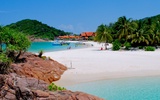Beaches
There are plenty of beautiful beaches between the two main islands, suitable for sunbathing and swimming.
In Perhentian Kecil, the most popular beaches are Coral Bay and Long Beach, both located in the middle of the island. There are other beaches in the northern part of the island, accessible via the walking trail and water taxis.
In Perhentian Besar, the most popular beaches are on the west side of the island. Like those in Perhentian Kecil, the beaches in Perhentian Besar are accessible by foot and boat.
Water Activities
Perhentian Islands are famous among snorkelers and scuba divers as there is plenty of beautiful coral and unique species of marine life in the area, including sea turtles and sharks.
Travellers can also go on a day trip to the nearby Redang Island. Travellers planning to do this can ask around the local dive shops for packages.
Kayaking is also possible on the islands, and there are several places for travellers to rent a kayak. Jet skiing and water skiing, however, are prohibited on the islands to avoid any damage to the corals.
Jungle Trekking
Walking trails connecting beaches are available on both islands. Travellers might encounter wild animals, such as big monitor lizards, spiders and monkeys, during their walk. However, they are generally harmless.
Those who want to do trekking will need to wear proper shoes and bring enough drinking water since some of the trails are quite steep.
Nightlife and Shows
There are several bars in Perhentian Kecil’s Long Beach for those who are looking for drinks and cocktails. Note that they can be quite expensive. There is also a nightly fire show near a bar called Pirates of Perhentian, as well as open-air movie nights at Ombak Cafe.

